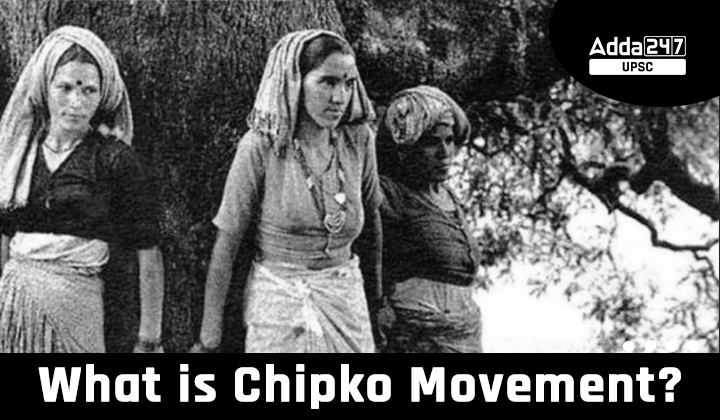Table of Contents
The Chipko Movement, a significant ecological and social movement which has begun in 1973 in the Himalayan region of Uttarakhand, India (then part of Uttar Pradesh). The Chipko Movement was mainly driven by rural villagers, particularly women, to protect forests from government-backed logging operations.
What is Chipko Movement?
The Chipko Movement was a significant environmental movement. It aimed to safeguard forests from deforestation through community participation and nonviolent resistance. Local villagers, notably women, hugged trees to prevent their felling. The movement heightened awareness about the ecological significance of forests and advocated for the rights of local communities. It inspired similar movements and influenced the formulation of environmental conservation policies in India.
Chipko Movement in India
The Chipko Movement, also known as the Chipko Andolan, emerged in the 1970s as a nonviolent social and environmental movement championed by rural Indian peasants, particularly women. Its primary objective was to safeguard forests and trees from government-backed logging activities. Originating in Uttarakhand, then part of Uttar Pradesh, the movement employed a unique strategy of tree-embracing to impede loggers, hence the name “Chipko,” derived from the Hindi word meaning “to hug or cling to.” For the local communities, the Chipko conflict represented a fight for survival, driven by the belief that their fundamental rights had been violated by the actions of state institutions.
The movement also highlighted the meticulousness of the locals, the crucial role of women in protecting their homes and families, and the significant support garnered for the anti-alcohol campaign, all of which contributed to the overwhelming backing from women in the movement.
Chipko Movement Objective
The primary objective of the Chipko Movement was to protect forests from deforestation and advocate for sustainable forest management practices. It aimed to reform forest management practices, raise environmental awareness, and empower local communities in the conservation and protection of forests. Key objectives of the movement included:
- Forest Conservation: The Chipko Movement aimed to prevent the indiscriminate felling of trees and the destruction of forests, particularly due to commercial logging activities
- Community Participation: The movement sought to involve local communities, especially women, in decision-making processes regarding the use and management of forest resources. It emphasized the importance of their traditional knowledge and the need for their consent in forest-related activities.
- Nonviolent Resistance: The Chipko Movement employed nonviolent methods, such as tree-hugging and sit-ins, to physically prevent loggers from cutting down trees. It aimed to create a peaceful resistance movement that raised awareness about the consequences of deforestation.
- Ecological Awareness: The movement aimed to increase awareness about the ecological significance of forests and the adverse impacts of deforestation on the environment, biodiversity, and water resources. It sought to educate people about the importance of maintaining a balanced ecosystem.
- Socio-Economic Justice: The Chipko Movement highlighted the socio-economic injustices faced by local communities dependent on forests for their livelihoods. It called for equitable distribution of forest resources, recognition of the rights of indigenous and marginalized communities, and addressing the economic disparities in resource utilization.
- Sustainable Development: The movement advocated for sustainable development practices that harmonize human activities with the preservation of natural resources. It emphasized the need for responsible and balanced use of forest resources to meet present needs without compromising the needs of future generations.
Chipko Movement History
In 1962 Indo-China conflict, the road construction was promoted by the government in areas of Uttarakhand. This attracted foreign logging companies, eager to exploit the region’s forest resources. Uncontrolled logging led to deforestation resulting in reduced agricultural yield and increased flooding.
The Chipko Movement emerged in the early 1970s in Uttarakhand, India. The movement gained significant momentum following the incident in 1973 in the village of Mandal, where local villagers, led by Gaura Devi, hugged trees to prevent their felling. This act of nonviolent resistance drew attention to the plight of the forests and the importance of community involvement in their conservation. Environmental activists like Sunderlal Bahuguna and Chandi Prasad Bhatt played instrumental roles in spreading awareness and mobilizing communities.
The movement quickly expanded to other villages, with women playing a prominent role in protecting the forests they relied upon for their livelihoods. The Chipko Movement brought national and international attention to the connections between environmental conservation, community rights, and sustainable development. Its impact led to policy and legal reforms in India, including the enactment of forest conservation laws and the recognition of community rights over forest resources. The Chipko Movement remains an inspiring example of grassroots environmental activism and has had a lasting influence on environmental movements globally.
Important Leaders of Chipko Movement
Chandi Prasad Bhatt
- Gandhian social activist and environmentalist.
- Founded Dasholi Gram Swarajya Mandal (DGSM) to promote rural industries using local resources.
- Played a key role in uniting villagers against unsustainable deforestation and shaping the Chipko Movement.
Sundarlal Bahuguna
- Inspired by Gandhian principles of non-violence and socialism.
- Crucial in organizing local communities and spreading awareness about the ecological importance of forests.
- Instrumental in mobilizing widespread support for the movement.
Gaura Devi
- A village woman and symbol of resistance.
- Led a group of women in Reni to physically embrace trees, preventing their cutting.
- Her leadership turned Chipko into a women-led movement, inspiring women across India.
Notable Environmental Movements in India
Bishnoi Movement: Led by Amrita Devi, this early environmental movement saw villagers in Khejuli, Rajasthan.
Chipko Movement: Led by Sunderlal Bahuguna, the movement aimed to protect trees in the Himalayan region from being felled by contractors involved in the Tehri Dam project.
Silent Valley Movement: Initiated by the Kerala Sastra Sahitya Parishad in 1978. This movement opposed the Silent Valley Hydroelectric Project to protect the biodiversity of the Silent Valley Park.
Appiko Movement: This movement started in 1982 in the Western Ghats region of Karnataka to resist the government’s plans to replace natural forests with teak plantations.
Save Aarey Movement: This movement was started in 2019, Medha Patkar and Arundhati Roy opposed the felling of trees in Aarey Colony for the construction of the Mumbai Metro.
Save Dehing-Patkai Movement: This movement was started in 2019 in Assam. This movement led by activists like Rohit Chaudhary and Joi Jadav Payeng against the government’s decision to allow coal mining in the Dehing-Patkai Wildlife Sanctuary.
Save the Sundarbans: This movement was started in 2019 for raise a awareness about the threats to the Sundarbans mangrove forest after Cyclone Amphan in May 2020.
Chipko Movement Conclusion
In conclusion, the Chipko Movement stands as a powerful and influential environmental movement that originated in the 1970s in Uttarakhand, India. Through nonviolent resistance, community participation, and raising awareness about the ecological significance of forests, the movement successfully brought attention to the detrimental effects of deforestation and commercial logging. Led by local villagers, especially women, the movement emphasized the need for sustainable forest management practices and the recognition of community rights.
The Chipko Movement inspired similar grassroots movements and led to policy and legal reforms in India. Its legacy continues to resonate globally, highlighting the importance of community-led environmental activism, conservation efforts, and the pursuit of sustainable development practices. The Chipko Movement remains an enduring symbol of the power of collective action and the ability of local communities to protect and preserve their natural resources for future generations.
| Related Articles | |
| Khilafat Movement in India | Bishnoi Movement |
| Quit India Movement | Indian Civil Disobedience Movement |
| Bhakti Movement and Sufi Movement | Socio-Religious Reform Movements |



 TSPSC Group 1 Question Paper 2024, Downl...
TSPSC Group 1 Question Paper 2024, Downl...
 TSPSC Group 1 Answer key 2024 Out, Downl...
TSPSC Group 1 Answer key 2024 Out, Downl...
 UPSC Prelims 2024 Question Paper, Downlo...
UPSC Prelims 2024 Question Paper, Downlo...





